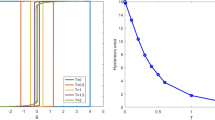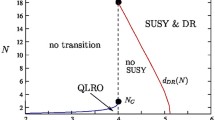Abstract
A lot of progress has been made recently in our understanding of the random-field Ising model thanks to large-scale numerical simulations. In particular, it has been shown that, contrary to previous statements: the critical exponents for different probability distributions of the random fields and for diluted antiferromagnets in a field are the same. Therefore, critical universality, which is a perturbative renormalization-group prediction, holds beyond the validity regime of perturbation theory. Most notably, dimensional reduction is restored at five dimensions, i.e., the exponents of the random-field Ising model at five dimensions and those of the pure Ising ferromagnet at three dimensions are the same.




Similar content being viewed by others
References
Aharony, A., Imry, Y., Ma, S.-K.: Lowering of dimensionality in phase transitions with random fields. Phys. Rev. Lett. 37, 1364 (1976)
Young, A.P.: On the lowering of dimensionality in phase transitions with random fields. J. Phys. A 10, L257 (1977)
Parisi, G., Sourlas, N.: Random magnetic fields, supersymmetry and negative dimensions. Phys. Rev. Lett. 43, 744 (1979)
Bricmont, J., Kupiainen, A.: Lower critical dimensions of the random-field Ising Model. Phys. Rev. Lett. 59, 1829 (1987)
Fytas, N.G., Martín-Mayor, V.: Universality in the three-dimensional random-field Ising model. Phys. Rev. Lett. 110, 227201 (2013)
Fytas, N.G., Martín-Mayor, V.: Efficient numerical methods for the random-field Ising model: finite-size scaling, reweighting extrapolation, and computation of response functions. Phys. Rev. E 93, 063308 (2016)
Picco, M., Sourlas, N.: Diluted antiferromagnetic 3D Ising model in a field. Europhys. Lett. 109, 37001 (2015)
Fytas, N.G., Martín-Mayor, V., Picco, M., Sourlas, N.: Phase transitions in disordered systems: the example of the random-field Ising model in four dimensions. Phys. Rev. Lett. 116, 227201 (2016)
Fytas, N.G., Martín-Mayor, V., Picco, M., Sourlas, N.: Specific-heat exponent and modified hyperscaling in the 4D random-field Ising model. J. Stat. Mech. 033302 (2017)
Fytas, N.G., Martín-Mayor, V., Picco, M., Sourlas, N.: Restoration of dimensional reduction in the random-field Ising model at five dimensions. Phys. Rev. E 95, 042117 (2017)
Sourlas, N.: The \(\epsilon \) expansion and universality in three dimensions (2017). arXiv:1706.07176
Landau, L.D., Lifshitz, E.M.: Quantum Mechanics. Pergamon Press, Oxford (1965)
Tissier, M., Tarjus, G.: Supersymmetry and its spontaneous breaking in the random field Ising model. Phys. Rev. Lett. 107, 041601 (2011)
Tissier, M., Tarjus, G.: Nonperturbative functional renormalization group for random field models and related disordered systems. IV. Supersymmetry and its spontaneous breaking. Phys. Rev. B 85, 104203 (2012)
Tarjus, G., Balog, I., Tissier, M.: Critical scaling in random-field systems: 2 or 3 independent exponents? Europhys. Lett. 103, 61001 (2013)
Parisi, G., Sourlas, N.: Scale invariance in disordered systems: the example of the random-field ising model. Phys. Rev. Lett. 89, 257204 (2002)
Kardar, M.: Replica Bethe ansatz studies of two-dimensional interfaces with quenched random impurities. Nucl. Phys. B 290, 582 (1987)
Medina, E., Kardar, M., Shapir, M., Wang, X.R.: Interference of directed paths in disordered systems. Phys. Rev. Lett. 62, 941 (1989)
Brézin, E., De Dominicis, C.: New phenomena in the random field Ising model. Europhys. Lett. 44, 13 (1998)
Brézin, E., De Dominicis, C.: Interactions of several replicas in the random field Ising model. Eur. Phys. J. B 19, 467 (2001)
Parisi, G.: Order parameter for spin-glasses. Phys. Rev. Lett. 50, 1946 (1983)
Mandelstam, S.: Soliton operators for the quantized sine-Gordon equation. Phys. Rev. D 11, 3026 (1975)
Coleman, S.: Classical lumps and their quantum descendants. In: Aspects of Symmetry: Selected Erice Lectures, pp. 185–264. Cambridge University Press, Cambridge (1985).
Mandelstam, S.: Soliton operators for the quantized sine-Gordon equation. Phys. Rep. 23, 307 (1976)
Acknowledgements
We would like to thank Giorgio Parisi for his hospitality in Rome, where part of this work has been completed. V.M.-M. was partially supported by MINECO (Spain) through Grant No. FIS2015-65078- C2-1-P (this contract partially funded by FEDER). N.G.F. and M.P. acknowledge support by the Royal Society’s International Exchange Scheme 2016/R1.
Author information
Authors and Affiliations
Corresponding author
Rights and permissions
About this article
Cite this article
Fytas, N.G., Martín-Mayor, V., Picco, M. et al. Review of Recent Developments in the Random-Field Ising Model. J Stat Phys 172, 665–672 (2018). https://doi.org/10.1007/s10955-018-1955-7
Received:
Accepted:
Published:
Issue Date:
DOI: https://doi.org/10.1007/s10955-018-1955-7




